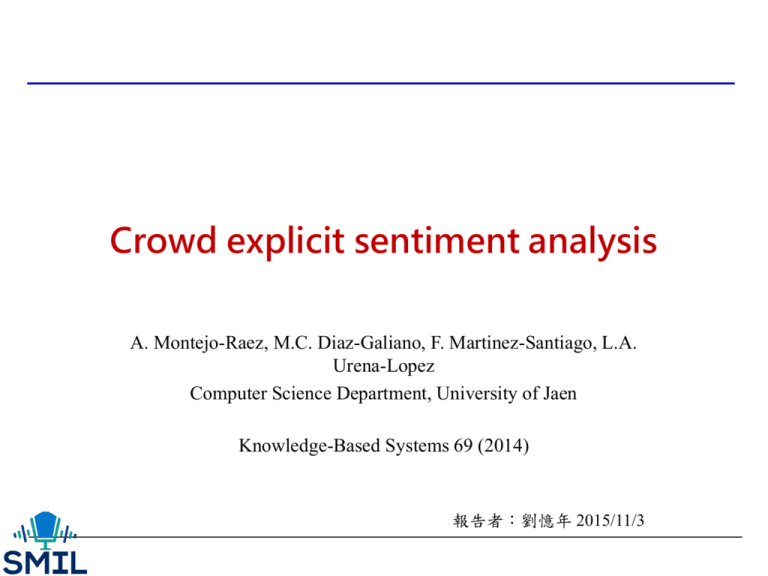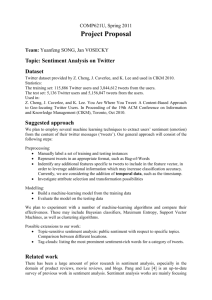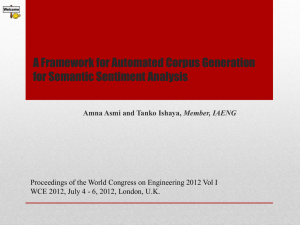Crowd explicit sentiment analysis (1/4)
advertisement

Crowd explicit sentiment analysis A. Montejo-Raez, M.C. Diaz-Galiano, F. Martinez-Santiago, L.A. Urena-Lopez Computer Science Department, University of Jaen Knowledge-Based Systems 69 (2014) 報告者:劉憶年 2015/11/3 Outline Introduction Sentiment analysis in social media Using the crowd to collect affective terms Crowd explicit sentiment analysis Experiments and results Conclusions and further work 2 Introduction (1/3) There is a significant increase in information sources and, therefore, data registered by our society since the advent of information and communication technologies. We all are now aware of it, but we may not realize the impressive numbers behind this fact. We cannot ignore this explosion and how Big Data has been revealed as the new major challenge in computation. Our ability to produce unlimited information may contrast with storage limits and computer performances, which, although still in continuous advance, may be overtaken soon by human and non-human uploaded data. 3 Introduction (2/3) This paper is only a small proposal on how we can face the new era of overwhelming availability of information, providing a strategy based on the construction of knowledge from that continuous stream of data by keeping a tiny, but filtered, part of it. In fact, we do not have to, as we have just too much of it. New knowledge can be constructed with the help of simple heuristics. It is similar to the approach followed by our brain, which is also filtering at every second thousands of incoming stimuli, generating from the rest what may not be the best understanding of reality, but a knowledge more than valid for our survival as human beings. 4 Introduction (3/3) Following this reasoning, we have designed an approach to polarity classification in sentiment analysis. It can be considered a simple approach, but the results confirm its validity, encouraging us to discover new areas where the idea ‘‘Let the crowd express itself’’ could be applied. 5 Sentiment analysis in social media (1/3) Sentiment Analysis (also known as Opinion Mining) is one of the most active research areas in Natural Language Processing nowadays, with special interest in the classification of texts into positive, negative or neutral. Supervised strategies have reported the best results since the earliest studies and are still the choice for many solutions, from Information Theory based features (with SVM classifier) to more complex learned rules. Unsupervised approaches have relied mainly on the use of lexicons where words are associated with polarity scores, although more advanced solutions using intensive lexical analysis are proposed or using deep learning approaches, the latter being a very promising and innovative way to tackle the problem. 6 Sentiment analysis in social media (2/3) The second group of proposals (unsupervised ones) are mainly based on the creation of a list of affective terms, which is, again, usually closely related to the domain of the targeted texts and hard to generate in different languages. At any rate, these studies follow the line of concept-level sentiment analysis, as the analyzed texts are represented by a vector of ‘‘feelings’’ rather than pure term vectors. Most of these knowledge bases do not consider contextual information that may modify the polarity of collected concepts, as some terms may become subjective when accompanying certain words, or even completely change their polarity values when used along with some modifiers or within the context of certain phrases. 7 Sentiment analysis in social media (3/3) Twitter has been found to be very useful in many scenarios, like real-time Recommender Systems, cinema revenue prediction or even crime prediction, among others. 8 Using the crowd to collect affective terms -- The WeFeelFine project (1/3) Since the year 2005, the website WeFeelFine1 has been harvesting from social media millions of sentences containing ‘‘I feel’’ or ‘‘I am feeling’’ expressions, creating a huge database of sentences related to feelings or emotions. Although the main goal of the project is to serve as a monitor of the human state at a global level, we found that the collected data could be useful in sentiment analysis. The current list of feelings stored contains 2178 different feelings, although the 200 most frequent ones represent 70% of a total of almost 2 million sentences. These are the ones considered in this study. 9 Using the crowd to collect affective terms -- The WeFeelFine project (2/3) 10 Using the crowd to collect affective terms -- The WeFeelFine project (3/3) WeFeelFine is a very interesting project and its continuous trawling of data could represent a valuable resource in sentiment analysis, as considered by previous studies, where a bag of sentiment words is created using WeFeelFine lists of feelings and augmented with synonyms and antonyms from Thesaurus. 11 Using the crowd to collect affective terms -- The MeSientoX corpus (1/2) As the generation of a feelings database based on simple regular expressions is not a difficult task, we decided to test this approach for Spanish. Instead of translating the texts from the WeFeelFine database, almost two million Spanish tweets that contain the words ‘‘me siento’’ (‘‘I feel’’) were collected by means of the Twitter API. The tweets were retrieved during 35 days, between December 2012 and January 2013, collecting a total of 1,863,758 tweets. Our first attempt at polarity classification with this data was performed with promising results [self-reference removed], and also with a retrieval based solution. 12 Using the crowd to collect affective terms -- The MeSientoX corpus (2/2) A unified form is the merging of the two forms derived from genre variants in Spanish, so tweets with the expression ‘‘Me siento cansada’’ or ‘‘Me siento cansado’’ would be under the same feeling cansado. We also discarded those unified forms that could be considered non-sentiment words, such as words in a non-Spanish language (alone, crazy). This is the only step involving human intervention, though the effort is minimal (the emotions extracted were labeled in less than ten minutes). The number of sentiment words selected was 201 (the most frequent ones), of which 84 were considered as positive and 117 as negative from a total number of different unified forms of 344. 13 Crowd explicit sentiment analysis (1/4) Explicit Semantic Analysis proposes the use of a collection of documents to form the indexes of new documents. In our case, the WeFeelFine data is taken as the base for generating English feelings documents, whereas tweets extracted from MeSientoX are used to generate Spanish feelings documents. Each feeling X is represented as a compilation of the tweets retrieved containing the expression Me siento X, assuming that the term X refers to a feeling. Thus, instead of projecting a document onto a space of articles, it is projected onto a space of feelings collected automatically from social media posts. The distances of the vector are cosine distances obtained by means of a Latent Semantic Analysis. 14 Crowd explicit sentiment analysis (2/4) 15 Crowd explicit sentiment analysis (3/4) Therefore, a document is preprocessed to obtain its vector and then multiplied by a low-rank approximation (by Singular Value Decomposition) of the feeling-to-term matrix created from the corpora generated from microblog posts. 16 Crowd explicit sentiment analysis (4/4) This second way of computing the final polarity value only takes into consideration the order of the feelings, not the actual distance of them to the target document. As feelings ‘‘emerge’’ from the collected data, and due to the randomness of texts captured, the cosine distance may not add relevant information to the model. 17 Crowd explicit sentiment analysis -- Integrating SenticNet 3 The last one available (3-beta) has been enhanced by considering further knowledge sources. Although even fewer concepts are considered in SenticNet 3 compared to SenticNet 2, the inclusion of common and common sense knowledge has resulted in a most coherent net of emotional concepts. We found that it could be the straightforward solution for labeling crowd-based emotional concepts (feelings). 18 Experiments and results (1/4) For the English experiments, the Emoticon data set from Stanford University was selected. In order to enable the comparison of results with other approaches, only the test set is considered. It contains 177 negative tweets and 182 positive tweets, manually labeled. For experiments with Spanish, we selected the SFU Review corpus. It is composed of 400 reviews divided into eight categories: cars, hotels, washing machines, books, cell phones, music, computers, and movies. Each category contains 50 positive and 50 negative reviews, defined as positive or negative based on the number of stars given by the reviewer (1–2 = negative; 4–5 = positive; 3-star reviews are not included). These reviews were collected from the Ciao web site. 19 Experiments and results (2/4) 20 Experiments and results (3/4) This finding makes us think of the complexity of sentiment representation, so documents are better represented by several emotional states instead of pure polarity classes. This is in agreement with a treatment of the sentiment analysis problem at a concept-level. One reason for such a behavior may be the big difference in the quality of the texts between the two data sets. WeFeelFine provides good grammar and very few misspellings or jargon terms and sentences are longer and richer in expressiveness, whilst the compilation of tweets in the case of MeSientoX corpus is far from well written Spanish. Also, the cosine distance may not reflect the real contrast between different feelings in the latter case. 21 Experiments and results (4/4) Nevertheless, the accuracy obtained is high, taking into consideration that there is no normalization over the text obtained from WeFeelFine and neither over the test data. Thus, our approach shows that good performance can be obtained with this straightforward solution, based purely on capturing emotional expressions from blogs and other channels of social communication. In this case, the results of our approach outperform the lexical based solution proposed by these authors. 22 Conclusions and further work (1/3) Crowd Explicit Sentiment Analysis has been introduced as a stream-based approach for polarity classification. Its simple design allows for the construction of polarity classifiers in different languages and domains without the need for complex linguistic resources or architectures. Nevertheless, further research has to be performed as many issues could be explored in order to improve the proposed method. For example, we have found that large quantities of texts without relevant content are captured by the expressions used. Thus, a selection of terms and posts has to be done. 23 Conclusions and further work (2/3) Thus, the difference in the accuracy value may be due to the length of the documents or related to language issues. This needs further analysis and study by exploring more comparable corpora. Therefore, a more accurate capturing technique could be useful, although it is in the intent of the method to avoid too sophisticated solutions, as its strength lies in its simplicity. 24 Conclusions and further work (3/3) Nevertheless, we plan to use these methods but constructing the models using the vectors of feelings that CESA generates. Social based representation of emotions has been found as a valid solution to model affective communication. It could outperform the two approaches for final polarity calculation, as we expect to confirm with future experimentation. In any case, the solutions that could be constructed based on the idea of ‘‘let the crowd express itself’’ are very suitable for big data environments. We believe that on-line learning algorithms and evolving training data could be the key to modeling the knowledge that emerges from the vast amount of texts published every second, everywhere. 25





